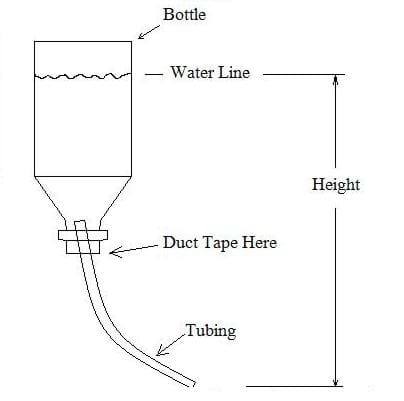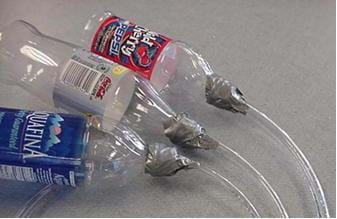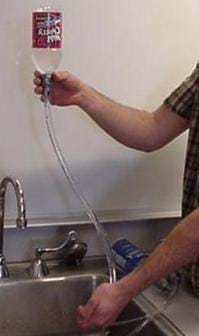Quick Look
Grade Level: 6 (5-7)
Time Required: 45 minutes
Expendable Cost/Group: US $2.00
Group Size: 2
Activity Dependency: None
Subject Areas: Physical Science
NGSS Performance Expectations:

| 3-5-ETS1-1 |
| 3-5-ETS1-3 |
Summary
Students learn all about water pressure and how engineers design faucets. Teams build simple systems that model faucets and test them to see the relationships between pressure, area and force. This is a great outdoor activity on a warm day and gives students experience in experimentation, design and teamwork. A student worksheet is provided for guidance and data collection.Engineering Connection
Engineers exploit the relationships between, pressure, force, area and work when designing different mechanical and fluid systems. Fluid systems may include the piping system in and throughout a single building or a whole city water system. The design of pumps and valves for the piping system include pressure and work calculations. Another example that uses the concepts of fluid and mechanical systems is the heating and ventilation system in a building—a damper in an air duct acts like a valve in a piping system, but for air instead of water.
Learning Objectives
After this activity, students should be able to:
- Explain how water pressure changes with height.
- Describe how the area of an opening affects the force of water flow.
- Design and evaluate a model faucet.
Educational Standards
Each TeachEngineering lesson or activity is correlated to one or more K-12 science,
technology, engineering or math (STEM) educational standards.
All 100,000+ K-12 STEM standards covered in TeachEngineering are collected, maintained and packaged by the Achievement Standards Network (ASN),
a project of D2L (www.achievementstandards.org).
In the ASN, standards are hierarchically structured: first by source; e.g., by state; within source by type; e.g., science or mathematics;
within type by subtype, then by grade, etc.
Each TeachEngineering lesson or activity is correlated to one or more K-12 science, technology, engineering or math (STEM) educational standards.
All 100,000+ K-12 STEM standards covered in TeachEngineering are collected, maintained and packaged by the Achievement Standards Network (ASN), a project of D2L (www.achievementstandards.org).
In the ASN, standards are hierarchically structured: first by source; e.g., by state; within source by type; e.g., science or mathematics; within type by subtype, then by grade, etc.
NGSS: Next Generation Science Standards - Science
| NGSS Performance Expectation | ||
|---|---|---|
|
3-5-ETS1-1. Define a simple design problem reflecting a need or a want that includes specified criteria for success and constraints on materials, time, or cost. (Grades 3 - 5) Do you agree with this alignment? |
||
| Click to view other curriculum aligned to this Performance Expectation | ||
| This activity focuses on the following Three Dimensional Learning aspects of NGSS: | ||
| Science & Engineering Practices | Disciplinary Core Ideas | Crosscutting Concepts |
| Define a simple design problem that can be solved through the development of an object, tool, process, or system and includes several criteria for success and constraints on materials, time, or cost. Alignment agreement: | Possible solutions to a problem are limited by available materials and resources (constraints). The success of a designed solution is determined by considering the desired features of a solution (criteria). Different proposals for solutions can be compared on the basis of how well each one meets the specified criteria for success or how well each takes the constraints into account. Alignment agreement: | People's needs and wants change over time, as do their demands for new and improved technologies. Alignment agreement: |
| NGSS Performance Expectation | ||
|---|---|---|
|
3-5-ETS1-3. Plan and carry out fair tests in which variables are controlled and failure points are considered to identify aspects of a model or prototype that can be improved. (Grades 3 - 5) Do you agree with this alignment? |
||
| Click to view other curriculum aligned to this Performance Expectation | ||
| This activity focuses on the following Three Dimensional Learning aspects of NGSS: | ||
| Science & Engineering Practices | Disciplinary Core Ideas | Crosscutting Concepts |
| Plan and conduct an investigation collaboratively to produce data to serve as the basis for evidence, using fair tests in which variables are controlled and the number of trials considered. Alignment agreement: | Tests are often designed to identify failure points or difficulties, which suggest the elements of the design that need to be improved. Alignment agreement: Different solutions need to be tested in order to determine which of them best solves the problem, given the criteria and the constraints.Alignment agreement: | |
Common Core State Standards - Math
-
Know the formulas for the area and circumference of a circle and use them to solve problems; give an informal derivation of the relationship between the circumference and area of a circle.
(Grade
7)
More Details
Do you agree with this alignment?
International Technology and Engineering Educators Association - Technology
-
Explain how knowledge gained from other content areas affects the development of technological products and systems.
(Grades
6 -
8)
More Details
Do you agree with this alignment?
State Standards
Colorado - Math
-
Add, subtract, multiply, and divide decimals to hundredths.
(Grade
5)
More Details
Do you agree with this alignment?
-
Develop and apply formulas and procedures for area of plane figures.
(Grade
6)
More Details
Do you agree with this alignment?
Materials List
Each group needs:
- 2-3 empty plastic 10-16 oz bottles
- 2-3 2-foot sections of plastic tubing of varying diameters
- 3 feet of duct tape
- 1 bucket or catch basin
- 1 gallon of water
- corks or rubber stoppers
- scissors
- Too Much Pressure Worksheet
Worksheets and Attachments
Visit [www.teachengineering.org/activities/view/cub_faucets_lesson1_activity1] to print or download.Pre-Req Knowledge
Some knowledge about diameter and area to complete Part 3 of this activity, measurement.
Introduction/Motivation
Have you ever played outside with a garden hose on a warm day? What happens to the flow of water when you bend the hose in half? (Answer: The water stops flowing.) What happens when you put your finger over the end of the hose? (Answer: The water sprays or the water flow stops.) Sometimes you can get the water in the hose to come out in a small stream, but then this stream comes out faster and the water shoots farther across the yard. Why is that? It happens because the smaller opening increases the velocity (speed) and pressure of the water coming out of the hose.
What happens when you swim in the deep end of a pool? What happens as you go deeper and deeper in the pool? Your ears may begin to hurt. In fact, your ears hurt because of the pressure of the water. How do you think water pressure and depth is related? (Have students discuss the answer with the person sitting next to them and then discuss their answers as a class.) The deeper you go the more pressure there is and the more your ears hurt. The same thing is true for air pressure (another fluid) and height. The higher in the air you go, the more pressure you feel in your ears.
These things are determined by the properties of fluid flow (in these examples, air and water). Fluid flow and fluid properties are concepts that engineers need to know about when designing a many things, including the water plumbing for our houses, buildings and schools, etc. Engineers need to think about how water is going to get through pipes, and ultimately to our sinks. They need to think about how to get enough pressure for the water to flow through the pipes and the faucets, so we can wash our hands or get a drink of water.
Today we are going to experiment with some of the properties of fluid flow. We are going to play with water, do some measurements, and think like an engineer to use what we learned in designing a faucet.
Procedure
Background
The measurement portion of this activity is modeled after the following equation:
Q = V*A
where Q = flow (ft3/min or gallons/minute), V = Velocity (ft/min), and A = Area (ft2)
For example, as your thumb decreases the area across the tube (kind of like closing a valve at the end of the tube), per the equation above, a decrease in area results in a higher velocity, assuming the flow stays the same. It is similar to putting your thumb over the end of a garden hose to get it to spray further. Assuming the flow is constant, a decrease in area results in a higher velocity of the fluid so that it shoots further out, or puts more pressure on your thumb.
Before the Activity
- A week prior to the activity, ask students to bring in empty/rinsed plastic soda bottles to accumulate a supply for the activity.
- Gather materials and assemble supplies for each group.
- Make copies of the Too Much Pressure Worksheet, one per group.
- Cut off the bottom ends of the bottles. Alternatively, include this task for students to do in step 1 of the Assembly.
With the Students
Introduction and Design Challenge
- Present to the class the Introduction/Motivation content to kick off the project.
- Organize the class into groups of two students each.
- Distribute supplies and a worksheet to each group.
- Make sure students understand that today they are going to work as if they are engineers who are trying to figure out the best design for a faucet.
Part 1: Assembly
Have students assemble the pressure testing device as follows, which is also provided as assembly instructions on the worksheet.

- Insert the plastic tubing about one inch into the top of a bottle (as shown in Figure 1).
- Wrap duct tape around the tube and bottle top in order to form a watertight seal, as shown in Figure 2.

- Have one student hold her thumb securely over the end of the tube.
- While holding the device over a catch basin, have a second student fill the bottle about ¾ full with water.
- Still over the catch basin, hold the bottle 2 feet above the end of the tube (where you thumb is stopping the water at the end of the tube), as illustrated in Figure 3.

Part 2: Experiment
- Have teams follow the steps of the experiment as outlined on the worksheet.
- Have students answer the corresponding worksheet questions.
Part 3: Measurement
- Have students measure the diameter and area of the tubes in their experiment and record their measurements on the worksheet. Note: The worksheet requires students to calculate the area of each tube. If time is limited, skip this step by the teacher providing the area of each tube.
- Have students repeat the steps of the experiment with the next two different bottles.
Part 4: Engineering Design
- Have students think about their experiment and measurement. How can they use what they learned to design a faucet?
- Permit students to use available supplies such as corks, stoppers, tape, and anything else, to make the final part of their faucets, which will ultimately control the water flow.
- Have them draw their designs on their worksheets.
Assessment
Pre-activity Assessment
Prediction: Ask students to predict the following answers (relationships):
- How are pressure and height related?
- How are area and pressure related?
Activity Embedded Assessment
Worksheet: Have students record measurements and follow along with the activity on the Too Much Pressure Worksheet. After the worksheets are completed, have students compare answers with their peers. Review the worksheet answers to gauge their mastery of the subject.
Post Activity Assessment
Worksheet Discussion: Review and discuss the worksheet answers with the entire class. Use the answers to gauge students' mastery of the subject.
Prediction Analysis: Have students compare their initial predictions with their test results, as recorded on the worksheets. Ask the students to explain how pressure, area and height are related.
Show and Tell: Have the students "show and tell" to the rest of the class the faucet designs they created, explaining their work to the other students.
Safety Issues
Remind students to be careful with the water and not let it splash anywhere but into the catch basin.
Troubleshooting Tips
In order to see a difference in the force for different areas, water pressure must be kept the same. This is maintained by making sure to hold up the plastic bottles such that the top water line is always at approximately the same height.
Activity Extensions
As a class, generate a list of a few characteristics of water on the board or someplace where everyone can see them. Then, ask the students to think of a common item that an engineer designed with that fluid property in mind. Examples of fluid characteristics might include that water flow increases with height or depth, water force increases with smaller opening, that water has to be held together in a container, etc.
Have the students think about the pressure in a water column. How much pressure is there at the deepest point in the ocean, the Mariana trench? First, find the depth of the trench and use the hydrostatic pressure gradient equation to calculate the pressure ( ). Research the answer at http://www.marianatrench.com/
Activity Scaling
For younger students, eliminate the area calcuation and provide more specific instructions.
Subscribe
Get the inside scoop on all things TeachEngineering such as new site features, curriculum updates, video releases, and more by signing up for our newsletter!More Curriculum Like This

Students learn about the underlying engineering principals in the inner workings of a simple household object – the faucet. Students use the basic concepts of simple machines, force and fluid flow to describe the path of water through a simple faucet.

Students examine in detail the water cycle components and phase transitions, and then learn how water moves through the human-made urban environment. Students show their understanding of the process by writing a description of the path of a water droplet through the urban water cycle, from the dropl...

Students are introduced to Pascal's law, Archimedes' principle and Bernoulli's principle. Fundamental definitions, equations, practice problems and engineering applications are supplied.

Students learn about the fundamental concepts important to fluid power, which includes both pneumatic (gas) and hydraulic (liquid) systems.
Copyright
© 2006 by Regents of the University of ColoradoContributors
Chris Sheridan; Jackie Sullivan; Malinda Schaefer Zarske; Janet Yowell; Melissa StratenSupporting Program
Integrated Teaching and Learning Program, College of Engineering, University of Colorado BoulderAcknowledgements
The contents of this digital library curriculum were developed under grants from the Fund for the Improvement of Postsecondary Education (FIPSE), U.S. Department of Education and National Science Foundation (GK-12 grant no. 0338326). However, these contents do not necessarily represent the policies of the Department of Education or National Science Foundation, and you should not assume endorsement by the federal government.
Last modified: April 24, 2020










User Comments & Tips